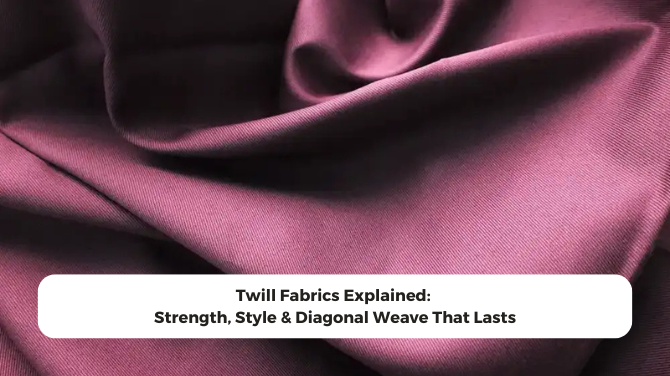If you’ve ever owned a pair of jeans that felt like they could survive a decade, you’ve already met twill — you just didn’t know its name. Twill fabric has quietly worked its way into our closets, upholstery, uniforms, and even the insides of luxury bags. It’s not loud or showy, but once you understand how it’s made and why it’s used, you’ll see just how foundational it is to the world of clothing and textiles.
So, what exactly are twill fabrics?
Twill isn’t a material — it’s a weave. That means it’s a way of structuring yarns on a loom to make a fabric. What makes twill stand out is its distinct diagonal pattern. Unlike plain weaves that go over one, under one, twill follows a more staggered pattern — like over two, under one — which shifts with each row. That’s what gives it that iconic slanted look, often called a “twill line.”
The angle of the twill line can vary too. Some are steep, some are more relaxed, and that changes both the look and feel of the final fabric.
Why does everyone love twill fabrics?
There’s a reason manufacturers, designers, and even workwear brands swear by twill. It all comes down to three main things:
1. Durability that lasts
Twill is tough. That tight, structured weave doesn’t just look pretty — it holds up against wear and tear. That’s why denim, which is a type of cotton twill, is the go-to for everything from construction gear to weekend casuals.
2. Better drape, fewer wrinkles
Unlike plain weave fabrics that can feel stiff and prone to creasing, twill fabrics tend to drape better on the body. They’re also less likely to wrinkle, which makes them a great option for trousers, shirts, jackets, and even dresses that need structure but flexibility.
3. Versatility in finishes
Because twill works well with a range of fibers — cotton, polyester, wool, blends — it can be finished in all kinds of ways. Want something soft and brushed? Easy. Something crisp and sharp? Also doable. That flexibility makes it a favorite across both casual and formalwear.
The many faces of twill
Twill isn’t a one-trick pony. Here are a few popular types you’ve definitely seen or worn:
- Denim: The classic. Usually made from cotton, and always woven with a blue warp and white weft.
- Chino: A lightweight cotton twill, popular in trousers. Clean, polished, and softer than denim.
- Gabardine: A tightly woven wool or cotton twill, often used in suits and outerwear.
- Drill: A heavy-duty cotton twill, ideal for uniforms and workwear.
- Herringbone and houndstooth: Fancy versions of twill where the weave creates broken or zigzag patterns.
Each of these fabrics starts from the same core structure — twill — but the yarn, weight, and finish take them in completely different directions.
Where does twill show up in real life?
Just look around. That sturdy tote bag you carry every day? Could be cotton twill. Those slim-fit trousers you rely on for work? Probably chino twill. Your favorite fall blazer? Likely a wool twill.
Even interiors aren’t off-limits. Twill shows up in furnishing fabrics, curtains, and even car seat covers, thanks to its strength and resistance to stains and fading.
How twill helps garment makers and designers
If you’re in the business of making clothes, twill gives you room to play. It’s:
- Easy to cut and stitch without excessive fraying
- Available in a wide range of weights
- Ideal for both structured and relaxed silhouettes
Checkout our fabric digital catalogue
Plus, the diagonal texture adds a layer of visual depth, making even plain-dyed fabrics feel a little more elevated.
Final thoughts: Twill isn’t trendy — it’s timeless
Twill isn’t chasing fashion cycles. It doesn’t need to. It’s one of those quietly powerful fabrics that’s been around for centuries and is still going strong because it works. It delivers comfort, structure, and longevity — all in one neat diagonal package.
So the next time you’re thumbing through fabric swatches or browsing for fabric-rich styles, pause and notice the texture. If there’s a subtle slope running through it, you’ve probably got yourself a piece of twill — and trust me, that’s always a good thing. If you are looking for a reliable woven fabric manufacturer, please contact us.

